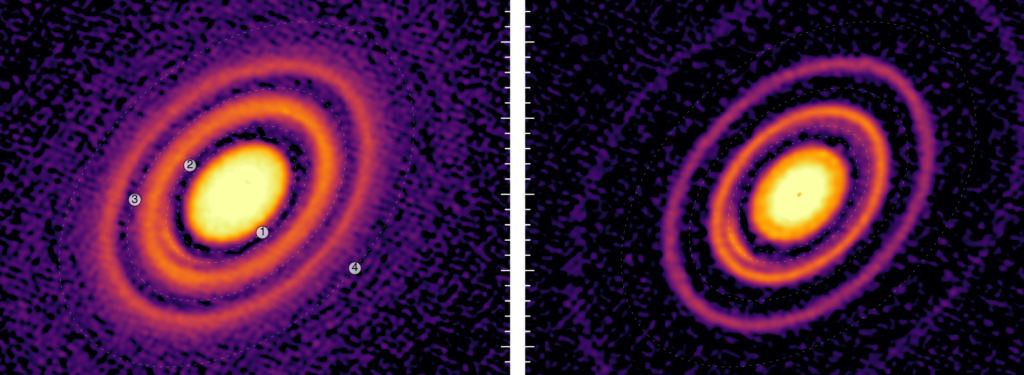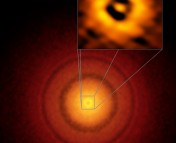Title: A Gap-Sharing Planet Pair Shaping the Crescent in HD 163296: a Disk Sculpted by a Resonant Chain
Authors: Juan Garrido-Deutelmoser, Cristobal Petrovich, Carolina Charalambous, Viviana V. Guzmán, and Ke Zhang
First Author’s Institution: Instituto de Astrofísica, Pontifica Universidad Católica de Chile
Status: Submitted to ApJ Letters [open access]
An extra protoplanet might be lurking in the dust around a nearby star.
The pre-main sequence star HD 163296 plays host to an extensive circumstellar disk, with gas reaching out beyond 500 AU. Observations of this disk have revealed it to be quite the playground for the young planets forming within — and these authors claim there are more planets than previously thought.
HD 163926’s disk has a series of rings — bumps and dips in surface brightness, corresponding to over- and under-densities of material at different distances from the host star (Figure 1). Observations of this sort of ringed structure have become common fare since the advent of high-precision millimeter imaging in the last fifteen years. These rings imply the presence of protoplanets or other large, substellar bodies, which can clear out gaps through their growth, and which generally alter what would otherwise be a smooth(er) profile.

Trying to figure out the exact setup of bodies that gives a disk its observed structure is an interesting problem — and in the case of HD 163296, it’s a problem that has proven a bit tricky.
It only took low-resolution images of this particular disk (like those taken with the Hubble Space Telescope at the turn of the century) for Grady et al. to suggest that a giant planet might be present in the outer reaches of this system. Jumping ahead to 2018, Teague et al. used rotation curves of observed gas to claim that there were likely two planets out there — both roughly as massive as Jupiter, at 87 and 113 AU. Just a few months later, high-precision observations by the Atacama Large Millimeter Array (ALMA) revealed that the disk contains not just a series of gaps, but also an intriguing substructure within the innermost one.
Today’s paper focuses on this gap, which extends from 38 to 62 AU, and the crescent-shaped region near the edge of it that appears to have more material than it should (Figure 1).
The standard idea that gaps form along the orbit of a protoplanet doesn’t allow for this sort of uneven, crescent-shaped structure; the protoplanet should clear the material evenly all the way around the orbit, but it seems to have missed a spot. Modeling this gap, and the substructure within, would complete our current understanding of the HD 163296 system.
Luckily, the crescent has a fairly straightforward explanation. To understand it, though, we need to talk about Lagrange points.

If you’ve taken a class on classical mechanics, you might remember that Lagrange points are sort of like gravitational islands. For any pair of massive bodies (say, a star with a protoplanet), there are five points where the gravitational forces of the bodies balance nearly perfectly to keep much-less-massive things at those points — fixed, relative to the more massive bodies. Two of these (L4 and L5) are stable against small displacements, meaning smaller things like asteroids and dust often accumulate at or around these two points. L4 lies almost exactly on the orbit of the less-massive body, in front of it by ~60 degrees. L5 trails behind the less-massive body by the same angle (Figure 2).
In the HD 163296 system, this crescent-shaped region with extra dust and gas could perhaps be explained as a build-up of material in the L4 or L5 of some massive protoplanet, which had otherwise cleared out the gap. In 2021, Rodenkirch et al. simulated the interactions between a gap-clearing planet and the dust around it, and they showed that this could work: a Jupiter-mass planet orbiting the star at 48 AU would both open up the observed gap and trap a significant amount of dust at its trailing L5.
And so the system was solved. The crescent-shaped substructure in HD 163296’s disk was the result of a Jupiter-mass planet. The other gaps were caused by two other planets further out.
And yet, today’s featured paper came out just last week. Why?
It turns out there were two problems with the Lagrange point idea. First, the crescent is centered at a radial distance of 55 AU, which requires a lot of dynamical hoop-jumping-through to make sense for a Jupiter-mass planet at 48 AU. Second, a Jupiter-mass planet would open up a deep gap in the gaseous disk. Less than a year after the first submission of Rodenkirch et al. (2021), observations by Zhang et al. of the disk’s carbon monoxide (CO) surface density — a great tracer for the overall gas density throughout a disk — showed that the gas gap between 38 and 62 AU is ten times shallower than it would be if it were carved by a Jupiter-mass planet.
Enter Garrido-Deutelmoser et al. Last year, they studied the effects of having two planets in the same gap in a protoplanetary disk. Through hydrodynamical simulations, they showed that, if they’re close enough to each other, the gravitational interactions of two sub-Jupiter-mass planets would create relatively stable “vortices” at L4 and L5 of either of the planets. These vortices could maintain over-densities of dust and gas for thousands of orbits — plenty of time for us to have observed one of them.
In today’s featured paper, Garrido-Deutelmoser (and a slightly different) et al. applied this concept to HD 163296. They set up simulations of the system mostly matching those of Rodenkirch et al., with the two proposed outer planets and a smooth disk of gas and dust. But in place of one Jupiter-mass planet at 48 AU, they implanted two planets with a few times the mass of Neptune in that region. Since these two combine for a much smaller mass than Jupiter, they would create a much shallower gap in the gas density profile — ideally matching that found in Zhang et al.

Through trial and error, they found that planets at 46 and 54 AU did, in fact, carve out the appropriate density profile for this gap in both dust and gas (Figure 3) over the course of a half-million-year simulation. And in line with expectations from their previous work, material congregated at L5 for the outer super-Neptune (though they note that this ebbed and flowed over time). They do point out that neither their model nor the Rodenkirch et al. captured the density profile accurately beyond ~85 AU, which they explain might be an issue with gas dynamics beyond that point. Regardless, their two-planet model for the gap of interest seems to be a winner.
They close the paper with a final proposition, suggesting where in their orbits one might find each of the protoplanets, based largely on the fact that they seem to be close to a mean motion resonance chain — that is, they seem to have orbital periods that are roughly integer multiples of each other. Using a relationship for the orbital angles of objects in such a resonance, along with the location of the crescent and observations of kinematic features in the gas, the authors infer the precise locations of each of the protoplanets within the disk (Figure 4).
In the end, this might provide one final check for this finicky system. If the protoplanets are where they say they are, we’re golden. If not, the saga of HD 163296 will go on.

Astrobite edited by Lucie Rowland and Zili Shen.
Featured image credit: Garrido-Deutelmoser et al. (2023)





When I click on the link, I get
https://arxiv.org/abs/1804.02001
not
https://arxiv.org/abs/2301.13260
Thanks — should be fixed!